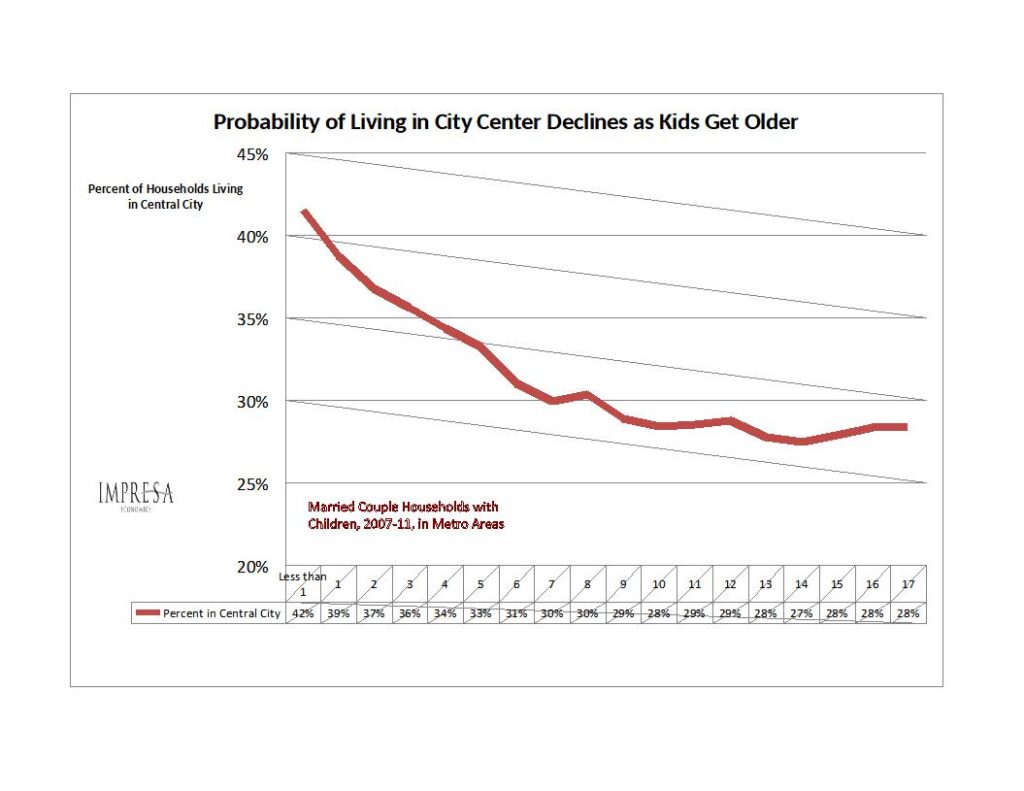Is there a place for families with children in cities?
For the past two decades, there’s been an increasing tendency for well-educated young adults to choose to live in close-in urban neighborhoods <link>. While many believe that dense urban enviornments make sense for singles and childless couples, there’s been growing interest in whether they will stay when they have children. For several decades, families with children have gravitated towards the nation’s suburbs. Will the young and restless living in the urban core stay there, or will they move outward as have previous generations?
Don’t all young families move to the suburbs?
The data suggest that some families with children, but by no means all, move away from the central city as their kids reach school age. Data from the American Community Survey show that of married couple households with children, the probability of living in the central city declines as the age of the household’s youngest child gets older. For those whose youngest kid is less than one, 42% of households live in the central city. For those whose youngest is 10 or older, its about 28% to 29%.
These data suggest that families with kids under 1 are about 50% more likely (42%/ 28%) to live in central cities than families with kids 10 or older. Because this Census data series doesn’t track individual families over time, we can’t directly tell how many families with children move from the central city to other locations in the metropolitan area, but these cross sectional data suggest that perhaps a third of married couple that have children move out of the central city as their children reach school age.
These data are taken from the American Community Survey using 5-year, 2007-2011 Census Tract level data , and were calculated using the IPUMS on-line table generator <link to IPUMS: https://usa.ipums.org/usa/>. The data use the “central city” classification defined by the Census (typically the largest or two largest municipalities in a metropolitan statistical area).
Data are from the 2007-11 American Community Survey.

Kids in Cities estimate
What factors influence whether families with young children choose to live in cities?
According to a Illinois Institute of Design studycommissioned by CEOs for Cities that interviewed families living with young children in cities, three factors are key: schools, space and safety. In each case, families living in cities report creatively tapping city assets to make city living kid-friendly: using the cities creative and cultural resources to enrich educaitonal opportunities, tapping parks, playgrounds and public spaces to compensate for small or no private yards, and relying on neighborhood networks to create the “eyes on the street” that enhance personal safety for kids and adults alike.
http://www.ceosforcities.org/research/kids-in-cities/
Are young people with children actually staying in cities?
Some anecdotal evidence suggests that young families with children are increasingly choosing to remain in urban centers. For the past two decades, Portland has been one of the nation’s leaders in attracting talented young adults, and they have disproportionately settled in the region’s close-in urban neighborhooods—within three miles of the center of the central business district. <Link to YNR Portland>.
Can we find a story about growing school enrollments in NYC.
What can cities do to accommodate families with children
Vancouver example.
8/80 cities.
